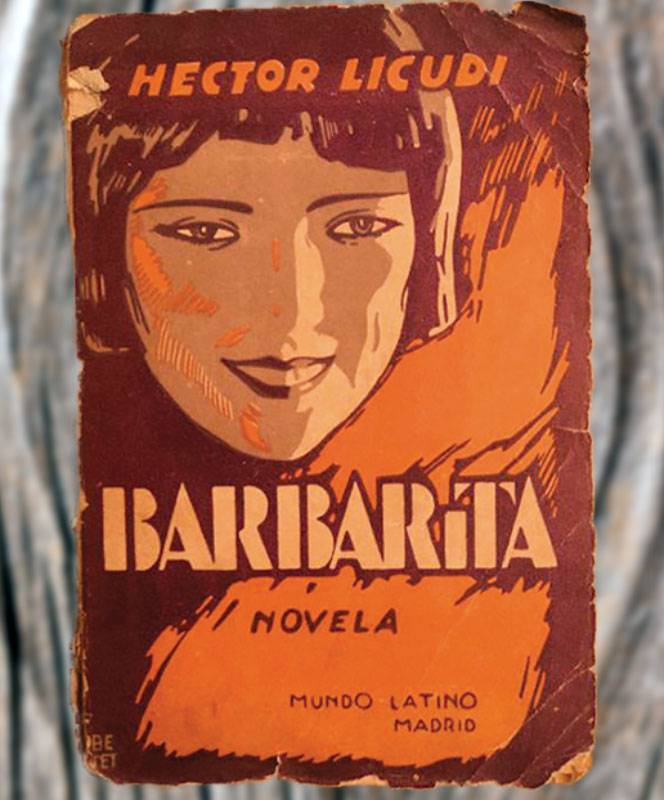Researchers José Juan Yborra and Iñaki Irijoa, authors of an upcoming investigative book that recalls the work of the Gibraltarian journalist and writer Hector Licudi, brings this lost Gibraltarian story back to the fore.

“Like many journalists of the 1920’s, Hector Licudi had always dreamed of making a name for himself as a writer. But his first and only book “Barbarita”, which was intended to be a romantic fiction based on real events in Gibraltarian society, came too close to reality and resulted in his exile from the Rock and nearly cost him his life… thus, putting an end to his literary ambitions”.
Algeciras researcher, professor José Juan Yborra has published a detailed study, soon to be put on sale, on the life of Hector Licudi – the author of what he calls a “forgotten and maligned” novel; “Barbarita”. Few copies of the original remain today.
Entitled “Barbarita, la novela galante de Gibraltar” (“Barbarita, a novel of gallantry in Gibraltar”), the book is a critical analysis of Licudi’s literary work, which is co-authored with Iñaki Irijoa, who is a specialist in Literary Studies and Comparative Literature. Together, their book aims to “vindicate Licudi and rescue his work from oblivion”. The publication is supported by the Campo de Gibraltar Press Association (APCG) and has been published in “Estrecho de Periodistas”.

ReachExtra was given access to the manuscript and, within the first few paragraphs, the significance of Licudi’s career was clear. He began his career at the Gibraltarian newspaper “El Anunciador” (one of the Spanish-language newspapers in Gibraltar at the time) which reflects what the profession was like in the roaring twenties.
In the 1920’s the Region Boasted a Generation of Highly Ambitious Young Journalists

At the time, the frontier between Gibraltar and Spain was much more permeable than it is now, and La Línea and Algeciras were going through a “golden age” for newspapers and magazines. Hector Licudi established a fluid relationship with many Spanish journalists and intellectuals who had in one way or another influenced his professional career.
“One could say that there was a ‘boom’ in newspapers in the region, with young journalists with common interests and an ambition to make a name for themselves in literature and who ended up forming a new “generation” of the kind that was also developing in other cultural and artistic circles… Names such as Rafael Argelés, Pérez Arriete, Ramón Puyol or Gustavo Bacarisas, among others – all of whom were working towards making a name for themselves outside a territory which had become too small for them: First they set their sights on Sevilla and then made the leap to Madrid”.

Yborra and Irijoa’s latest book explains that the Gibraltarian journalist Hector Licudi, like most of his contemporaries (90% of them wrote the kind of short novels which were popular at the time while making their living as journalists), used his articles to assert his status as a writer; capture his vision of life and, at the same time, try to carve out a place for himself within the lively literary culture in Spain.
Determined to make his mark, Licudi managed to get the Mundo Latino publishing house to publish “Barbarita” in 1929. This was to be a novel in a genre which was popular at the time, with which he aimed to gain money and fame – a story suffused with mild eroticism which, more often than not, never came to be seen as “official” literature and the vast majority of which ended up forgotten.
Barbarita: A Gallant Novel which was too Close to Reality and Nearly Cost Licudi his Life
However, according to the research carried out by Yborra and Irijoa, the influence of the then famous writer Eduardo Zamacois, who prefaced the book, ended up encouraging Licudi to go one step further, enriching a work, with marked autobiographical overtones, which was to about to cost him his life.

“In their final analysis, 50 percent of ‘Barbarita’ is made up of priceless descriptions of the Gibraltar of the time, with criticisms of British colonial power and very serious reflections on a city which Licudi he condemned as having a provincial character; an insular society where everyone knew each other and their private lives. For Licudi, who had a stormy love life, this must have been suffocating”.
“The man who defends Gibraltar has not yet been born”, wrote Licudi, who, only a just a few days after the publication of ‘Barbarita’, received such a brutal beating in the street, according to the writers, ended up in hospital.

“Once recovered, he fled to Madrid, never to return to Gibraltar, nor did he write any other novels. In any case, he had already achieved his purpose: to be recognized as a writer, which opened doors for him and permitted him to escape from a region which he felt trapped in”.
In Spain’s capital, he lived through the turbulent times of the Second Republiv, the Civil War and the post-war period working as a reporter and correspondent:
“Because he spoke perfect English and was a British national, he was not treated as just an ordinary journalist”, Yborra said, who did not want to reveal any spoilers from the investigation.
In a way, the investigation ends in the Anglo-American Hospital in Madrid, where, on the 23rd of October 1959 Licudi died at the age of 63 having become in the final stage of his professional life the most popular horseracing correspondent in Spain.
All that remains of his memory is a dusty plaque in the La Almudena cemetery, where his remains lie, and, of course, this book.



